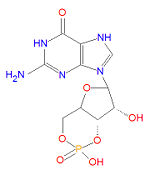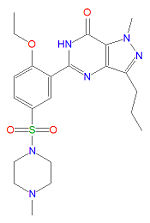Erectile dysfunction
Erectile dysfunction is a condition in which a male cannot obtain or maintain an erect penis.[1][2] It can result from several medical conditions, including diabetes, radical prostatectomy, vascular insufficiency, nerve damage, or insufficient cyclic guanine monophosphate (cGMP) levels.
Treatment
Phosphodiesterase type 5 inhibitors
Sildenafil (Viagra®), vardenafil (Levitra®) and tadalafil (Cialis®), often used to treat ED and as well as pulmonary hypertensive, are selective phosphodiesterase type 5 (PDE-5) inhibitors that bind selectively to PDE-5 and inhibit the binding and subsequent degradation of cGMP. Normally, erection results from increased cGMP levels produced by guanylate cyclase, which in turn is upregulated by nitric oxide release after stimulation. By decreasing the degradation of cGMP by PDE-5 enzymes increases the levels of cGMP in the corpus cavernosum and its supply vessels, relaxes the smooth muscle, and enables an erection. Viagra (sildenafil) was the first blockbuster drug for ED treatment in this class, although vardenafil is more potent in vitro. Both sildenafil and vardenafil have structural similarity to cGMP (and the unselective PDE inhibitor caffeine), with which they compete for binding of PDE-5 enzymes. Tadalafil is significantly different in structure but is thought to act by the same mechanism.
83% of men who used sildenafil had at least one episode of intercourse as compared to 45% who received placebo according to a systematic review of randomized controlled trials of using sildenafil.[3]
References
- ↑ Corbin JD, Francis SH (2003). "Molecular biology and pharmacology of PDE-5-inhibitor therapy for erectile dysfunction". J. Androl. 24 (6 Suppl): S38–41. PMID 14581493. [e]
- ↑ McVary KT (December 2007). "Clinical practice. Erectile dysfunction". N. Engl. J. Med. 357 (24): 2472–81. DOI:10.1056/NEJMcp067261. PMID 18077811. Research Blogging.
- ↑ Fink HA, Mac Donald R, Rutks IR, Nelson DB, Wilt TJ (June 2002). "Sildenafil for male erectile dysfunction: a systematic review and meta-analysis". Arch. Intern. Med. 162 (12): 1349–60. PMID 12076233. [e]

